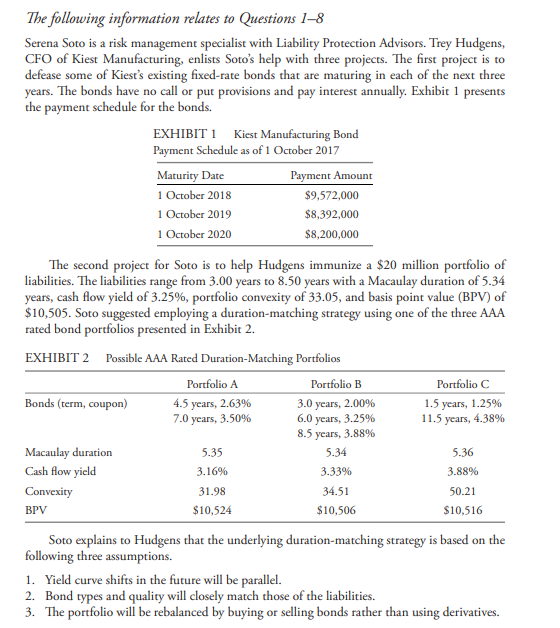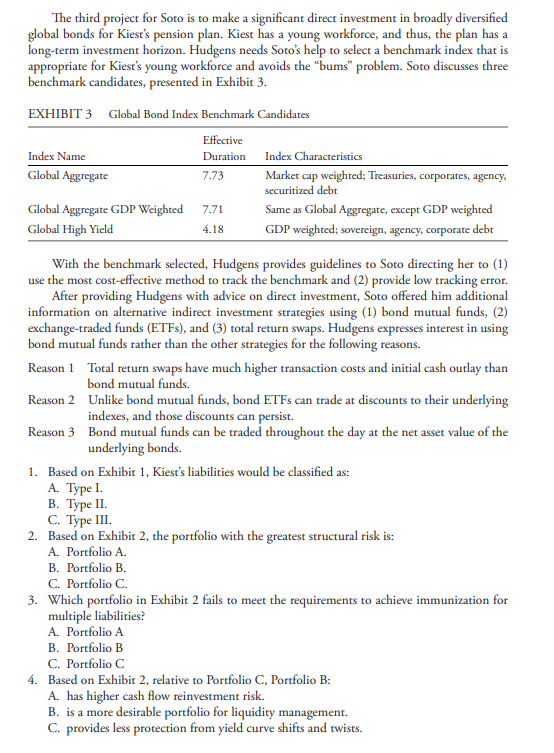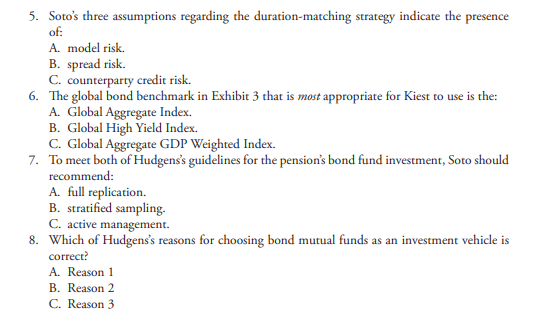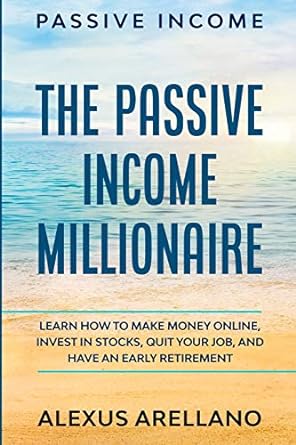


The following information relates to Questions 1-8 Serena Soto is a risk management specialist with Liability Protection Advisors. Trey Hudgens, CFO of Kiest Manufacturing, enlists Soto's help with three projects. The first project is to defease some of Kiest's existing fixed-rate bonds that are maturing in each of the next three years. The bonds have no call or put provisions and pay interest annually. Exhibit 1 presents the payment schedule for the bonds. EXHIBIT 1 Kiest Manufacturing Bond Payment Schedule as of 1 October 2017 Maturity Date Payment Amount 1 October 2018 $9,572,000 1 October 2019 $8,392,000 1 October 2020 $8,200,000 The second project for Soto is to help Hudgens immunize a $20 million portfolio of liabilities. The liabilities range from 3.00 years to 8.50 years with a Macaulay duration of 5.34 years, cash flow yield of 3.25%, portfolio convexity of 33.05, and basis point value (BPV) of $10,505. Soto suggested employing a duration-matching strategy using one of the three AAA rated bond portfolios presented in Exhibit 2. EXHIBIT 2 Possible AAA Rated Duration-Matching Portfolios Portfolio A Portfolio B Portfolio C Bonds (term, coupon) 4.5 years, 2.63% 3.0 years, 2.00% 1.5 years, 1.25% 7.0 6.0 years, 3.25% 11.5 years, 4.38% 8.5 years, 3.88% Macaulay duration 5.35 5.34 5.36 Cash flow yield Convexity 34.51 50.21 BPV $10,524 $10,506 $10,516 Soto explains to Hudgens that the underlying duration-matching strategy is based on the following three assumptions. 1. Yield curve shifts in the future will be parallel. 2. Bond types and quality will closely match those of the liabilities. 3. The portfolio will be rebalanced by buying or selling bonds rather than using derivatives. years, 3.50% 3.16% 3.33% 3.88% 31.98 The third project for Soto is to make a significant direct investment in broadly diversified global bonds for Kiest's pension plan. Kiest has a young workforce, and thus, the plan has a long-term investment horizon. Hudgens needs Soto's help to select a benchmark index that is appropriate for Kiest's young workforce and avoids the "bums problem. Soto discusses three benchmark candidates, presented in Exhibit 3. EXHIBIT 3 Global Bond Index Benchmark Candidates Effective Index Name Duration Index Characteristics Global Aggregate 7.73 Market cap weighted; Treasuries, corporates, agency, securitized debt Global Aggregate GDP Weighted 7.71 Same as Global Aggregate, except GDP weighted Global High Yield GDP weighted; sovereign, agency, corporate debt 4.18 With the benchmark selected, Hudgens provides guidelines to Soto directing her to (1) use the most cost-effective method to track the benchmark and (2) provide low tracking error. After providing Hudgens with advice on direct investment, Soto offered him additional information on alternative indirect investment strategies using (1) bond mutual funds, (2) exchange-traded funds (ETFs), and (3) total return swaps . Hudgens expresses interest in using bond mutual funds rather than the other strategies for the following reasons. Reason 1 Total return swaps have much higher transaction costs and initial cash outlay than bond mutual funds. Reason 2 Unlike bond mutual funds, bond ETFs can trade at discounts to their underlying indexes, and those discounts can persist. Reason 3 Bond mutual funds can be traded throughout the day at the net asset value of the underlying bonds. 1. Based on Exhibit 1, Kiest's liabilities would be classified as: A. Type I. B. Type II. C. Type III. 2. Based on Exhibit 2, the portfolio with the greatest structural risk is: A. Portfolio A. B. Portfolio B. C. Portfolio C. 3. Which portfolio in Exhibit 2 fails to meet the requirements to achieve immunization for multiple liabilities? A. Portfolio A B. Portfolio B C. Portfolio C 4. Based on Exhibit 2, relative to Portfolio C. Portfolio B: A. has higher cash flow reinvestment risk. B. is a more desirable portfolio for liquidity management. C. provides less protection from yield curve shifts and twists. 5. Soto's three assumptions regarding the duration-matching strategy indicate the presence of: A. model risk. B. spread risk. C. counterparty credit risk. 6. The global bond benchmark in Exhibit 3 that is most appropriate for Kiest to use is the: A. Global Aggregate Index. B. Global High Yield Index. C. Global Aggregate GDP Weighted Index. 7. To meet both of Hudgens's guidelines for the pension's bond fund investment, Soto should recommend: A. full replication. B. stratified sampling. C. active management. 8. Which of Hudgens's reasons for choosing bond mutual funds as an investment vehicle is correct? A. Reason 1 B. Reason 2 C. Reason 3









